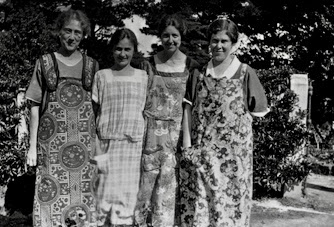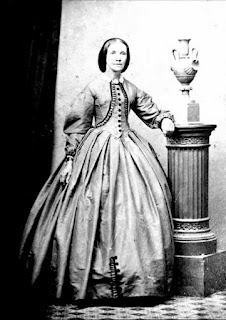28/52 Character: Dinah Hussey 1801 -1876
28/52 Character: Dinah Hussey :1801 - 1876
Dinah Hussey had character. She was my three times great grandmother. Her daughter, Rebekah Harris was the mother of Charlotte Hobbs, my grandmother’s mother, all four generations, women of tremendous character. In particular Dinah, pregnant, brought her five children under twelve by sea to the colony of South Australia. giving birth to her sixth child at sea. She and her husband built a market gardening business and a successful life in the colony.
This is what I know. Dinah was born in the depth of winter in December 1801 in Halberton, Devon. It must have been a beautiful place. The beauty of Devon was passed down in family stories so that when Norah Godlee travelled there in Spring in 1926 her mother, Dinah’s granddaughter, reminds Norah how her grandmother, (Dinah’s daughter who had left Devon when she was 5 years old,) ’…. delighted in Devon. She told me just the same about the lanes, the ferns and foxgloves. Oh, it must be enthralling to see.’
Dinah Hussey —————————-James Harris
I
Rebekah ————Jonah Hobbs
I
Charlotte —— Theodore Godlee
I
Norah Godlee
Dinah’s father was John and her mother was Dorothy May née Lehman. Both families had lived in Halberton, near Tiverton, for generations. Dinah was the oldest of nine children. She was baptised in the Anglican church.
During the early years of Dinah’s childhood a new branch of Methodism, Bible Christians, was born in Devon with 22 members and spread across England, Canada and Australia. They recognised the ministry of women. Perhaps Dinah heard Ann Mason preach. Another woman of character, she was a dressmaker but gave it up to take to the road as a preacher. She would walk up to 30 miles a day, travelling around Devon, preaching and withstanding hostility from people who disagreed with her. She argued that believers could be directly guided by God, which undermined church authority. Women made up 30% of Bible Christian ministers. Eventually Ann found Quakers. One way or another Dinah Hussey became a Bible Christian.
She married James Harris in the summer of 1826 in Cove. It seems to have been an Anglican wedding. They had Frederick in 1827, Elizabeth Hussey in 1829, Mary Ann in 1832. In 1834, Rebekah Jane is recognised as a Bible Christian birth in the non-conformist records. So at least by this date, Dinah and James were able to record their fourth child in the new faith. In 1837 Dinah gave birth to another son, George Henry.
James Harris was recorded as a shop keeper in Rebekah’s birth record. The 1830s was an economically hard time in Devon. These were the years of bad harvests, machine breaking, riots. Agricultural labourers had little money to spend in the Harris family shop. DInah and James decided to migrate to the South Australian colonies and boarded the Recovery, a three masted ship carrying 237 passengers.
She weighed anchor in London on May 19th, 1839. I wonder if she docked in Plymouth or if James and Dinah had to make an arduous trip to London. There were 110 adults and 65 children travelling under the Emigration Fund. The Harris/Husseys made a family group: as well as Dinah and James and their five children there was Dinah’s nineteen year old sister, Elizabeth Hussey. A Frederick Harris and possibly Ann, his wife, were perhaps James’ brother and sister-in-law. Dinah Harris, as well as caring for her five children under 12, was pregnant with her sixth. The children were Frederick, aged 12, Elizabeth 10, Mary Ann 7, Rebekah 5, and George, was 2. An 1893 Adelaide hospital admittance notice for Louisa Martin (née Harris) says that she was born in 1839 ‘at sea’.
It is hard to imagine how difficult this journey was. Thank goodness Elizabeth Hussey was there to support her sister. Reports of other sea voyages of the time tell of dreadful sea sickness and terrible rough seas washing over their bedding and making it impossible to cook and eat. Many babies born at sea didn’t survive but it seems that Louisa did. Captain Frome, after whom Frome Road was named, was on this ship, along with a company of sappers and miners.
They arrived in Port Adelaide on September 19th. after a four month journey. They were among 477 people who arrived in South Australia in 1839. They would have been taken to Emigration Square in carts, with their luggage and might have stayed there for a week, provided with food. Work was plentiful and well paid but food was expensive. In a letter by CC Saunders written in August 1839 a new migrant describes his accomodation - ‘one room of 24 feet by 19, mud walls and broad paling roof through which the morning sun shines in all its glory.’ (https://www.southaustralianhistory.com.au/adelaide1839.htm)
CC Saunders describes the country as ‘very beautiful, like living in a park.’ In 1839 there were still large numbers of Kaurna people looking after the land. . He writes of Kauna people, (the natives), ’very naked’ coming to the window while they were eating dinner. ‘In they marched opened their wide mouths, pointed to their throats and then also at the pudding.’ In the 1926 obituary of Dinah’s daughter-in-law, Sophia Jury who married Frederick, it is recalled that
‘she could relate many stories of her encounters with the blacks[sic] … it was necessary to pass a camp of aborigines near what is now known as Kingston Terrace and Robe Terrace. [on the way to a church service.]’
She also recalled they had been
on an old chain bridge over the Torrens near where the City Bridge now stands. They were accosted by a number of black fellows. She was only a child at the time, accompanied by her brothers. They had been to purchase sugar and the blacks demanded it. The little boy [her brother] gave up his parcel, but on Mrs Harris mentioning that she was one for Capt. Jury’s children the aborigines made off’.
Sophie Jury had arrived in Adelaide in 1842 when she was 8 years old.
Living on the banks of the Torrens
When the Harrises arrived, three years after the invasion in 1836, land in the town was already sold up but was still available further out. James Harris purchased land in Marden on the River Torrens which would have been prime Kaurna ground. According to my cousin Ian Hobbs in his family history book, Thomas Hobbs and Family, James Harris also bought land further up the Torrens in Campbell Town, Of course there were Kaurna people living here, fishing in the river and hunting red kangaroo, gathering native plants and it is unsettling to imagine what role James and Dinah played in destroying their culture and food supplies. They probably tried to convert them to Bible Christianity and gave them sugar, at the least.
James was not an agricultural labourer but a shop keeper so I imagine he had more money than some which perhaps he had used to buy tools and seeds which he brought with him to establish a market garden. They built a successful business and ten years later were able to employ a sixteen year old neighbour, Jonah Hobbs, whose family had established themselves next door. .
All the Harris children thrived and married, most of them remaining close to Marden. Frederick and Sophia called one of their children Dinah Hussey, following the tradition of naming their children with their mother’s maiden name. There were two other grandchildren named ‘Dinah’, but neither lived past infancy. Rebekah named a son ‘James Harris’, but he was always called ‘Harris’ (‘Uncle Harris’ in our family.)
The children stayed close to Bible Christians. Daughters, Elizabeth and Mary Ann married Bible Christians. Rebekah married a committed Primitive Methodist, that neighbour Jonah Hobbs. Frederick was active through his life in the Methodist church, either Wesleyan or Primitive. In 1901 the Bible Christians, the Primitive and Wesleyan Methodists amalgamated to form the Australian Methodist Church.
James Harris died from cancer on the 16th of May at home in Marden. He was 74 and had been in South Australia for 35 years. Dinah survived him by two years. She died on 23rd of November, 1876, aged 76. They were survived by 29 grandchildren.





Comments
Post a Comment